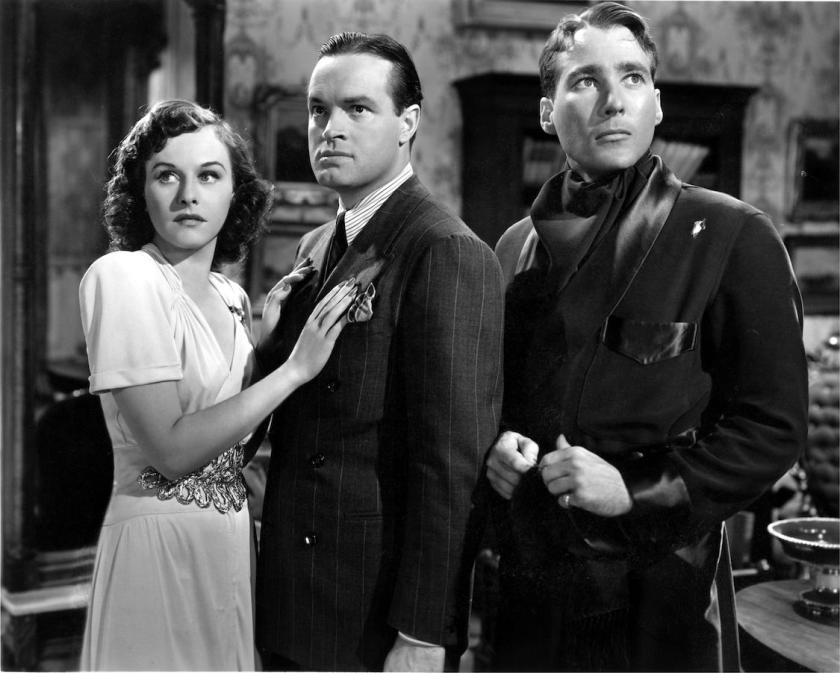Paramount added a late “old dark house” mystery comedy to Hollywood’s annus mirabilis of 1939 by teaming Bob Hope with Paulette Goddard in The Cat and the Canary, skilfully directed by Elliott Nugent. The death-trap mansion in the Louisiana bayous where family members gather to hear the reading of the deceased owner’s will – his niece Goddard inherits it – proved the perfect venue for Hope’s hilariously pusillanimous shtick.
The movie was a hit, so the stars were reunited in an identikit picture, 1940's The Ghost Breakers. Adding a gangster intrigue to the genre mash-up, it was based on a 1909 play by Paul Dickey and Charles W Goddard (no relation to the leading lady as far as I can determine) that had been filmed in 1914 and 1922 and would allegedly influence Ghostbusters.
It's a surprise to find that The Ghost Breakers, paired with the better-known The Cat and the Canary on Eureka!’s Blu-ray, is the more atmospheric film. In deftly handling its transition from a pre-noir gangland drama to a blend of voodoo-stoked exotica and lush Gothic melodrama, the reliable George Marshall (director also of Destry Rides Again and The Blue Dahlia) anticipated Val Lewton’s eerie 1940 horror classics. As in The Cat and the Canary, Charles Lang’s cinematography and Hans Dreier's sets counterpoint the farcical to-ings and fro-ings with nightmarishness.
 In stepping forward to protect Goddard’s latest legatee – this time she’s acquired a haunted Cuban castle worthy of Dracula – Hope’s crime columnist is bolder and more solicitous than his actor character in the first film. To cheer her up when she’s moping in their ship’s state room en route to Havana, he draws her into a nightclub pas de deux that allows them to mock the ghastly imaginary socialites skirting the floor. It's delicious, worth trying at home.
In stepping forward to protect Goddard’s latest legatee – this time she’s acquired a haunted Cuban castle worthy of Dracula – Hope’s crime columnist is bolder and more solicitous than his actor character in the first film. To cheer her up when she’s moping in their ship’s state room en route to Havana, he draws her into a nightclub pas de deux that allows them to mock the ghastly imaginary socialites skirting the floor. It's delicious, worth trying at home.
On the downside, The Ghost Breakers’ zombies are too dopey and artificial to raise a scare in a modern viewer. And the jokes Hope’s character makes about the skin color of his assistant, a stereotypically jittery African American played by Willie Best, are intolerable.
The Cat and the Canary was a remake of Paul Leni’s expressionist-lite but scarier 1927 silent adapted from John Willard’s 1922 play; it was Leni who introduced the trope of the hovering claw that menaces the heroine in her bed.
Though Hope’s characters fret for their own welfare, it is the hidden nighttime threat to the vivacious Goddard, rendered vulnerable by her femininity, that racks up the tension in both films. There’s no threat to her at all in a sequence in The Ghost Breakers that has her sauntering around in a slip as Hope, a voice on her radio, unwisely antagonises his gangster contacts.
Supporting actors add to the eerie fun, especially Douglass Montgomery, Gale Sondergaard and Nydia Westman (memorable as a shaky but plucky spinster) in The Cat and the Canary, and Best, Paul Lukas and the striking 25-year-old Anthony Quinn, who was cast in a dual role, in The Ghost Breakers.
These discs are modestly packaged with critics’ contributions, but The Ghost Breakers also features the 1949 NBC Theater radio adaptation wittily introduced by Marshall and starring Hope and Shirley Mitchell. It includes tiresome sexist humour the movie avoided.















Add comment